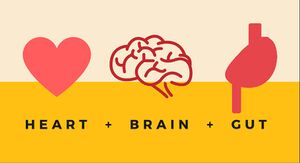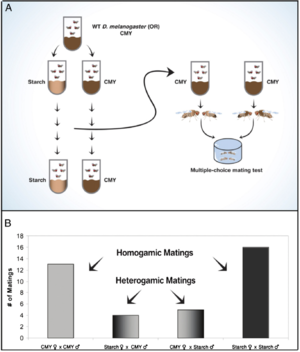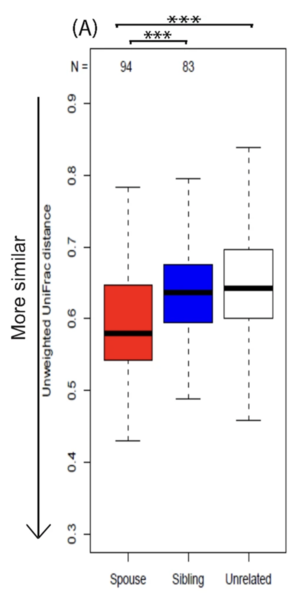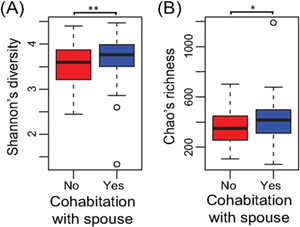Microbiome and Love: Difference between revisions
| Line 1: | Line 1: | ||
<!-- Do not edit this line-->{{Curated}} | <!-- Do not edit this line-->{{Curated}} | ||
==Introduction== | ==Introduction== | ||
[[Image:Heart-Brain-Gut.jpg|thumb|300px|right|The gut Microbiome influences your brain and love life. The photo credit for this image belongs to Jacqueline Quinn, who posted it on consciousnessliberty.com <ref name=a>[https://consciousnessliberty.com/using-your-heart-brain-gut-intelligences-collectively-to-make-better-decisions/]</ref>.]] | [[Image:Heart-Brain-Gut.jpg|thumb|300px|right|The gut Microbiome influences your brain and love life. The photo credit for this image belongs to Jacqueline Quinn, who posted it on consciousnessliberty.com <ref name=a>[https://consciousnessliberty.com/using-your-heart-brain-gut-intelligences-collectively-to-make-better-decisions/ Jacqueline Quinn, 2017, consciousnessliberty.com]</ref>.]] | ||
As free-thinking, decision making individuals, humans often believe that they get the final say in the choices that they make throughout their lives. These choices range from where individuals go to school, what to eat on a given day, and who to take as a perspective reproductive partner. But how many of these choices are actually under your control? It is a question that philosophers have debated for decades, but perhaps modern microbiology may be of help in answering it. Many individuals would be startled to learn that, perhaps, they are making less of their own independent choices and are more or less following along with the choices of the bacteria that inhabit their bodies. While a surprising revelation, it is one that science is starting to confirm to be true! | As free-thinking, decision making individuals, humans often believe that they get the final say in the choices that they make throughout their lives. These choices range from where individuals go to school, what to eat on a given day, and who to take as a perspective reproductive partner. But how many of these choices are actually under your control? It is a question that philosophers have debated for decades, but perhaps modern microbiology may be of help in answering it. Many individuals would be startled to learn that, perhaps, they are making less of their own independent choices and are more or less following along with the choices of the bacteria that inhabit their bodies. While a surprising revelation, it is one that science is starting to confirm to be true! | ||
Revision as of 00:22, 16 April 2022
Introduction

As free-thinking, decision making individuals, humans often believe that they get the final say in the choices that they make throughout their lives. These choices range from where individuals go to school, what to eat on a given day, and who to take as a perspective reproductive partner. But how many of these choices are actually under your control? It is a question that philosophers have debated for decades, but perhaps modern microbiology may be of help in answering it. Many individuals would be startled to learn that, perhaps, they are making less of their own independent choices and are more or less following along with the choices of the bacteria that inhabit their bodies. While a surprising revelation, it is one that science is starting to confirm to be true!
Commensal and symbiotic bacteria can be found all over and within the human body. While some occupy the skin, hair (members of bacterial species such as Staphylococcus), and mucosa of humans (members of bacterial species such as Streptococcus and Pseudomonas), many delve much further into the body: It is these bacteria that can have the most profound effect on human behaviors [2] [3]. With the human body playing host to over 2000 species of bacteria and 800 or more species occupying the human gut, there are a multitude of ways in which bacteria might be influencing the choices that humans are making [4].
Falling in love is one of the hallmarks of the human experience and is one of the biggest life changes than any individual will go through. Many unique changes occur at this time: Individuals make changes to their life schedules, changing their diet or sleep schedules, moving in together and cohabitating, sharing drinks, food and sleeping arrangements. New individuals enter their lives while others exit, each bringing their own unique set of bacteria, viruses and microbes. Thus, each individual is exposed to plenty of new colonizing opportunities for microbes that did not previously exist with the more solitary lifestyle of a single individual.
Within this page, we will discuss the changes that come about within the microbiome as individual organisms search for partners, “fall in love,” and go through periods of separation following relationship ending events. We will also cover how the human bodily microbiome, most specifically the gut microbiome, influences relationship variables such as how one goes about picking a life partner and what traits they are looking for. Finally, we will cover additional influences of the microbiome on romantic relationships, such as how bacteria are shared between individuals and the long-term health implications of these sharing events.
How the Gut Microbiome Influences Finding a Partner
The gut microbiome has large scale implications on behavior that have been well documented in many previous studies [5] [6] [7]. While it might seem that the gut and the microbiome contained within it are largely disconnected from the brain and the decision-making process in humans, that simply is not the case: The enteric nervous system (which includes all the nerves in the gut and, by default, all the bacteria and microbes that are capable of interacting with those nerves) is connected to the brain via the vagus nerve [8]. Thus, there is a direct avenue of information transport going from your gut microbiome all the way up to your brain. This pathway of interconnectedness not only allows for the sharing of information but also the transport of certain metabolites produced by the gut, including major neurotransmitters such as GABA ([8]). Therefore, the gut microbiome is directly influencing the functions of the brain via the enteric nervous system and the vagus nerve.
Since there is this extremely strong and powerful connection between the brain and the gut and its microbiota, a logical question would be to ask how the microbes of the gut might influence the decision making that organisms do, especially with regards to important decisions such as finding a mate in order to reproduce and pass on their genetics. While this is a difficult question to ascertain in large organisms such as humans, initial research can be conducted in other organisms to first determine if there is any basis to build future research off of. Thus, several very interesting experiments have been done in a variety of different model organisms in order to test how exactly the gut microbiome influences these important decisions of whom to mate with, when to mate, and whether to abandon one partner or environment for another.

Fruit flies, while physically quite different than humans, have a simple set of neurons that are easy to experiment with, along with an enteric nervous system that allows for the observation of gut-brain connections [9].Over the past 15 years, as the important nature of the gut in modulating behavior has become more apparent, research utilizing fruit flies for behavioral purposes related to the enteric nervous system has really taken off. One very complex study stands out in particular for its major findings: Flies would only try to mate with individuals who had a similar gut microbiome to themselves and would show no mating preference towards individuals with dissimilar gut microbiomes [9]. To test this, the researchers reared two different sets of flies on two different types of food; The idea here was that very different food types would lead to very different microbiome colonization within each group [9]. The flies were reared on their set food type from birth, and several successive generations (all the way up to 37) were continued on that specific media so that the microbiome could shift to being optimized for that media, and the researchers confirmed the differences in microbiome composition utilizing fecal microbiota analysis [9]. The researchers then took samples of flies from each of these groups and placed them together to observe mating behaviors, finding that flies would only mate with individuals reared on the same food type as themselves [9]. While this result implies that the flies are selecting only to mate with individuals similar to themselves, it does not explain why they are making those choices; therefore, the researchers, taking another small sample from the overall population of each group, treated the flies with a small dose of broad-spectrum antibiotics in order to kill off their gut microbes [9]. The results of this experiment are more telling, as now, flies displayed no preference for which group they mated with – that is, the removal of the gut microbes removed any instance of mating preference within the sample, adding evidence to the claim that the composition of the gut microbiome might influence who individuals decide to mate with [9]. While the exact mechanisms of how the microbes and their differences between groups were influencing the choices in who to mate with are not fully determined, the researchers hypothesized that the preference changes were due to the gut bacteria influence sex hormones to target individuals similar to themselves [9]. The drastic changes in mating preference between the two groups when not treated with antibiotics compared to after treatment definitely seems to imply that there is some sort of influence coming from the bacterial species that occupy the fruit fly gut. This influence, if it holds true for other species, would profoundly alter what humans tend to view as “free will” in their mating behaviors, and would be of special interest due to the large amount of antibiotics commonly prescribed!
How the Microbiome Changes for Partners
Include some current research, with at least one figure showing data.
At right is a sample image insertion. It works for any image uploaded anywhere to MicrobeWiki.
The insertion code consists of:
Double brackets: [[
Filename: PHIL_1181_lores.jpg
Thumbnail status: |thumb|
Pixel size: |300px|
Placement on page: |right|
Legend/credit: Electron micrograph of the Ebola Zaire virus. This was the first photo ever taken of the virus, on 10/13/1976. By Dr. F.A. Murphy, now at U.C. Davis, then at the CDC. Every image requires a link to the source.
Closed double brackets: ]]
Other examples:
Bold
Italic
Subscript: H2O
Superscript: Fe3+
[10]
A citation code consists of a hyperlinked reference within "ref" begin and end codes.
To repeat the citation for other statements, the reference needs to have a names: "<ref name=aa>"
The repeated citation works like this, with a forward slash.[2]
Microbiome Changes after Breakup
Include some current research, with at least one figure showing data.
Section 4
Conclusion
References
- ↑ Jacqueline Quinn, 2017, consciousnessliberty.com
- ↑ 2.0 2.1 Wakeam, E., R. A. Hernandez, D. Rivera Morales, S. R. G. Finlayson, M. Klompas, and M. J. Zinner. "Bacterial ecology of hospital workers' facial hair: a cross-sectional study." Journal of Hospital infection 87, no. 1 (2014): 63-67.
- ↑ Sanderson, Alicia R., Jeff G. Leid, and Darrell Hunsaker. "Bacterial biofilms on the sinus mucosa of human subjects with chronic rhinosinusitis." The Laryngoscope 116.7 (2006): 1121-1126.
- ↑ Shvets, Yu V., N. Yu Lukianova, and V. F. Chekhun. "Human microbiota and effectiveness of cancer chemotherapy." Exp Oncol 42 (2020): 82-93.
- ↑ Sharon, Gil, Timothy R. Sampson, Daniel H. Geschwind, and Sarkis K. Mazmanian. "The central nervous system and the gut microbiome." Cell 167, no. 4 (2016): 915-932.
- ↑ Ntranos, Achilles, and Patrizia Casaccia. "The microbiome–gut–behavior axis: crosstalk between the gut microbiome and oligodendrocytes modulates behavioral responses." Neurotherapeutics 15, no. 1 (2018): 31-35.
- ↑ Carlson, Alexander L., Kai Xia, M. Andrea Azcarate-Peril, Samuel P. Rosin, Jason P. Fine, Wancen Mu, Jared B. Zopp et al. "Infant gut microbiome composition is associated with non-social fear behavior in a pilot study." Nature communications12, no. 1 (2021): 1-16.
- ↑ 8.0 8.1 Forsythe, Paul, John Bienenstock, and Wolfgang A. Kunze. "Vagal pathways for microbiome-brain-gut axis communication." Microbial endocrinology: the microbiota-gut-brain axis in health and disease (2014): 115-133.
- ↑ 9.0 9.1 9.2 9.3 9.4 9.5 9.6 9.7 9.8 Sharon, Gil, et al. "Commensal bacteria play a role in mating preference of Drosophila melanogaster." Proceedings of the National Academy of Sciences 107.46 (2010): 20051-20056.
- ↑ Bartlett et al.: Oncolytic viruses as therapeutic cancer vaccines. Molecular Cancer 2013 12:103.
Authored for BIOL 238 Microbiology, taught by Joan Slonczewski, 2022, Kenyon College


